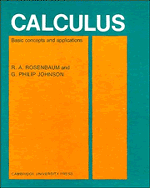Book contents
- Frontmatter
- Contents
- Preface
- How this book is organized, and how it can be used
- Some study hints
- 0 Prerequisites
- 1 Functional relationships
- 2 Rate of change
- 3 Applications of the derivative
- 4 Further differentiation
- 5 Antidifferentiation and integration
- 6 Exponential functions
- 7 Logarithmic functions
- 8 Differential equations
- 9 Further integration
- 10 Trigonometric functions
- Answers to selected problems
- Appendix: Tables
- Index
Preface
Published online by Cambridge University Press: 10 April 2010
- Frontmatter
- Contents
- Preface
- How this book is organized, and how it can be used
- Some study hints
- 0 Prerequisites
- 1 Functional relationships
- 2 Rate of change
- 3 Applications of the derivative
- 4 Further differentiation
- 5 Antidifferentiation and integration
- 6 Exponential functions
- 7 Logarithmic functions
- 8 Differential equations
- 9 Further integration
- 10 Trigonometric functions
- Answers to selected problems
- Appendix: Tables
- Index
Summary
Mathematics, with its origin in problems of land measurement and the keeping of accounts, has grown in complexity and power as the needs of society have required ever more sophisticated reasoning and techniques. Over a period of 2000 years mathematics developed, in some periods slowly, in others rapidly, until in the seventeenth century there was a dramatic advance – the invention of calculus – to match and facilitate equally dramatic achievements in science and, somewhat later, in technology.
Indeed, calculus proved essential for the handling of difficult problems in astronomy, physics, and engineering, as well as in other branches of mathematics itself, such as the determination of tangent lines to curves and the computation of volumes bounded by closed surfaces. In the eighteenth and nineteenth centuries, the demands of the physical sciences and technology stimulated rapid and far-reaching developments of the branch of mathematics called analysis, growing out of calculus; and, reciprocally, the mathematical developments contributed to the further growth of those sciences.
Comparable progress was not made in the applications of mathematics, including calculus, to the social and life sciences, largely because problems in these areas proved difficult to formulate in mathematical terms. With what precision – or even meaning – can one assign a number to the degree of a person's conviction on a controversial subject, such as the investment of more money to reduce the size of classes in public schools?
- Type
- Chapter
- Information
- CalculusBasic Concepts and Applications, pp. xi - xiiPublisher: Cambridge University PressPrint publication year: 1984



